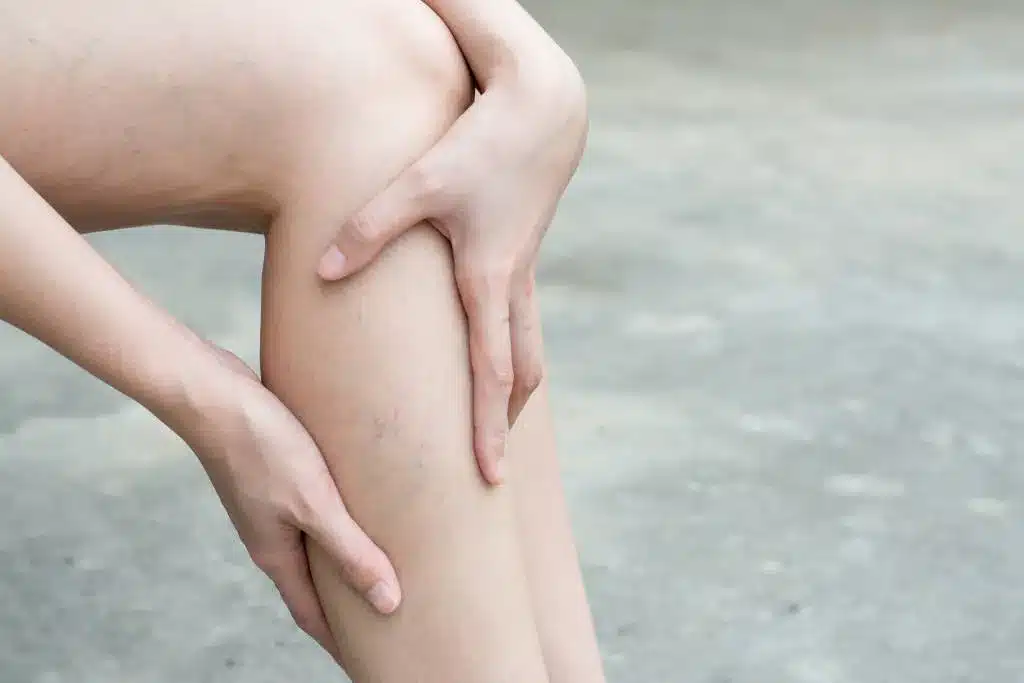Varicose veins are a common vascular condition affecting millions worldwide. While often considered a cosmetic concern, varicose veins can lead to complications, including bleeding from veins.
Understanding the causes and treatment options for varicose vein bleeding is essential for managing this condition effectively.
Here, we explore varicose vein bleeding treatment options and shed light on related concerns such as vein bursts and ruptures. Continue reading to learn more.

What is Varicose Vein Bleeding?
Varicose veins are enlarged, twisted veins commonly occurring in the legs due to weakened or damaged vein valves. When these veins become excessively dilated, they may rupture or burst, leading to bleeding. Varicose vein bleeding can range from minor to severe, causing discomfort and concern for individuals affected by this condition.
What Happens When Varicose Veins Burst?
Spontaneous and sudden bleeding from a vein is known as phleborrhagia.
Veins can burst and rupture when they become enlarged and weakened. This is especially common when the surrounding skin has experienced an injury or becomes softer, such as during a hot shower or bath.
Normal veins have a low pressure, unlike arteries that experience high pressures to deliver oxygen-rich blood to your body.
When someone has varicose veins, the veins enlarge due to weakened and dysfunctional valves. The enlarged veins grow, and the pressure keeps going up. Some veins have pressures almost equal to the arteries, especially those veins near your feet and ankles.
Life-threatening bleeding may occur in veins under these high pressures and cause blood to squirt, much like an artery would. This bleeding can cause much concern and alarm for individuals and their families.
To treat a vein that is bleeding, basic first aid is involved:
- Hold pressure over the area of bleeding with your finger or hand.
- Elevate the leg higher than the heart.
These instructions, while simple, can take time to implement. Anyone trying to hold pressure on their leg that’s bleeding while simultaneously getting their leg up over their head will attest to that difficulty.
If the bleeding does not stop with the above measures, medical attention should be sought immediately.
Causes of Varicose Vein Bleeding
Several factors contribute to the development of a ruptured varicose vein, including:
- Weak vein walls
- High blood pressure
- Physical trauma or injury to the varicose vein or surrounding area
- Prolonged standing or sitting
- Inflammation of the veins, such as phlebitis, can weaken vein walls and contribute to bleeding episodes.
Varicose Vein Rupture Treatment Options
Effective management of varicose vein bleeding involves addressing underlying venous insufficiency and preventing future bleeding episodes.
Once the bleeding is under control, the goal is to prevent recurrence through appropriate vein treatment options.
Treatment options for a vein burst in the leg may include:
- Compression Therapy: Wearing compression stockings can improve blood flow and reduce the risk of vein bursting.
- Sclerotherapy: This minimally invasive procedure involves injecting a solution into varicose veins to close them off, reducing the risk of bleeding.
- Endovenous Thermal Ablation: Thermal ablation uses laser or radio frequency energy to seal varicose veins shut, preventing bleeding and promoting vein closure.
Preventing Varicose Vein Bleeding
Taking proactive steps to manage varicose veins can help prevent bleeding episodes.
Lifestyle modifications such as regular exercise, elevation of the legs, and avoiding prolonged periods of standing or sitting can reduce venous pressure and minimize the risk of vein bursting. For personalized advice and treatment plans, the Tennessee Vein Center is a valuable resource for managing your vein health.
Varicose Vein Bleeding Treatment in Tennessee
If you, or someone you know, has experienced bleeding from a vein, it is important to get it checked out by a vein specialist.
Veins that bleed profusely are often under high pressure and, therefore, more likely to bleed again. Treatment closes those dysfunctional veins down to eliminate future bleeding episodes.
At Tennessee Vein Center, we offer specialized treatment options for various vein conditions, including vein bleeding.
Our dedicated team employs advanced techniques and personalized approaches to alleviate symptoms and promote healthier veins. Trust our comprehensive solutions for effective relief. Contact us today for expert treatment options near Knoxville.